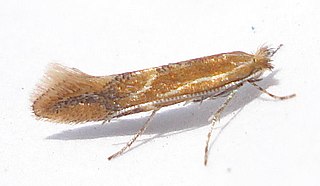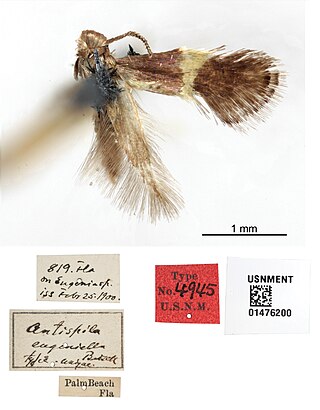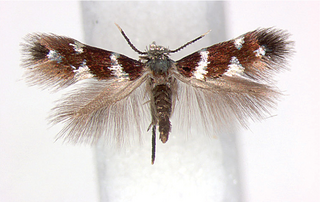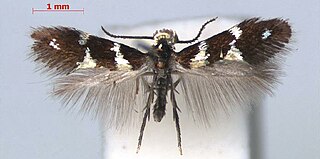
Anacampsis is a worldwide genus of moth with most found in the nearctic and neotropical regions. It is in the family Gelechiidae. The larvae feed on a range of deciduous trees and shrubs in a rolled or folded leaf, or spun shoot.

Cosmopterix is a large genus of moth in the family Cosmopterigidae.

Stigmella is a genus of moths of the family Nepticulidae. The genus was erected by Franz von Paula Schrank in 1802.

Phyllonorycter is a genus of moths in the family Gracillariidae.

Antispila argostoma is a moth of the family Heliozelidae. It was described by Edward Meyrick in 1916. It is found in India.
Antispila distyliella is a moth of the family Heliozelidae. It is found on the Ryukyu Islands in Japan.

Holocacista micrarcha is a moth of the family Heliozelidae. It was described by Edward Meyrick in 1926. It is found in India.
Antispila uenoi is a moth of the family Heliozelidae. It was described by Kuroko in 1987. It is found in Japan. In 2018, the species was found from China.

Holocacista is a genus of moths of the family Heliozelidae. It was described by Walsingham and Durrant in 1909.

Pseliastis is genus of moths in the family Heliozelidae, first described by Edward Meyrick in 1897. Three species are currently described, all endemic to Australia.

Gracillariinae are a subfamily of moths which was described by Henry Tibbats Stainton in 1854.

Epermenia is a genus of moths in the family Epermeniidae. The genus was first described by Jacob Hübner in 1825.

Aspilanta ampelopsifoliella is a species of moth in the family Heliozelidae. It is found in eastern North America. The larvae are leaf miners that feed on Virginia creeper and false Virginia creeper.

Heliozela eugeniella is a species of moth in the family Heliozelidae. It was described by August Busck in 1900 and is known only from Florida.

Aspilanta argentifera is a species of moth in the family Heliozelidae, first described by Annette Frances Braun in 1927. It is found in eastern North America. The larvae are leaf miners that feed on several species of plant in the family Myricaceae.

Aspilanta hydrangaeella is a species of moth in the family Heliozelidae. It is found in the United States. The larvae are leaf miners that feed on hydrangea plants.

Aspilanta oinophylla is a species of moth in the family Heliozelidae. It is native to North America and is an introduced species in Italy. The larvae are leaf miners that feed on several species of Vitaceae, including commercially important species of grapevine.

Aspilanta viticordifoliella is a species of moth in the family Heliozelidae. It is found in eastern North America. The larvae are leaf miners that feed on Virginia creeper, false Virginia creeper, and frost grape.

Aspilanta voraginella is a species of moth in the family Heliozelidae, first described by Annette Frances Braun in 1927. It is found in the United States. The larvae are leaf miners that feed on Vitis arizonica.

Aspilanta is a genus of very small moths in the family Heliozelidae that is native to North America. The larvae are leaf miners. Most Aspilanta species feed on Vitaceae with the exception of A. hydrangaeella and A. argentifera, which feed on species of hydrangea and Myricaceae respectively. The name of the genus is a partial anagram of Antispila.















